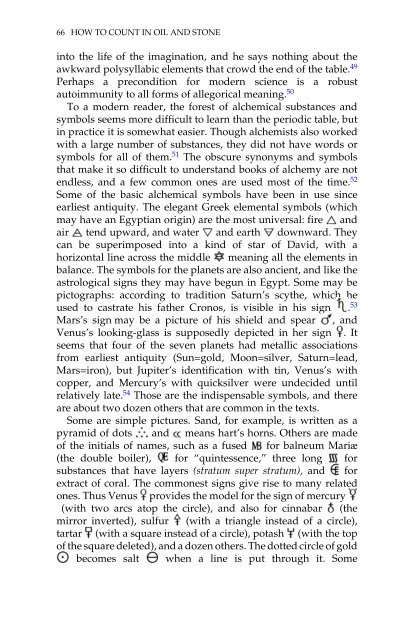What Painting Is: How to Think about Oil Painting ... - Victoria Vesna
What Painting Is: How to Think about Oil Painting ... - Victoria Vesna
What Painting Is: How to Think about Oil Painting ... - Victoria Vesna
You also want an ePaper? Increase the reach of your titles
YUMPU automatically turns print PDFs into web optimized ePapers that Google loves.
66 HOW TO COUNT IN OIL AND STONE<br />
in<strong>to</strong> the life of the imagination, and he says nothing <strong>about</strong> the<br />
awkward polysyllabic elements that crowd the end of the table. 49<br />
Perhaps a precondition for modern science is a robust<br />
au<strong>to</strong>immunity <strong>to</strong> all forms of allegorical meaning. 50<br />
To a modern reader, the forest of alchemical substances and<br />
symbols seems more difficult <strong>to</strong> learn than the periodic table, but<br />
in practice it is somewhat easier. Though alchemists also worked<br />
with a large number of substances, they did not have words or<br />
symbols for all of them. 51 The obscure synonyms and symbols<br />
that make it so difficult <strong>to</strong> understand books of alchemy are not<br />
endless, and a few common ones are used most of the time. 52<br />
Some of the basic alchemical symbols have been in use since<br />
earliest antiquity. The elegant Greek elemental symbols (which<br />
may have an Egyptian origin) are the most universal: fire and<br />
air tend upward, and water and earth downward. They<br />
can be superimposed in<strong>to</strong> a kind of star of David, with a<br />
horizontal line across the middle meaning all the elements in<br />
balance. The symbols for the planets are also ancient, and like the<br />
astrological signs they may have begun in Egypt. Some may be<br />
pic<strong>to</strong>graphs: according <strong>to</strong> tradition Saturn’s scythe, which he<br />
used <strong>to</strong> castrate his father Cronos, is visible in his sign . 53<br />
Mars’s sign may be a picture of his shield and spear , and<br />
Venus’s looking-glass is supposedly depicted in her sign . It<br />
seems that four of the seven planets had metallic associations<br />
from earliest antiquity (Sun=gold, Moon=silver, Saturn=lead,<br />
Mars=iron), but Jupiter’s identification with tin, Venus’s with<br />
copper, and Mercury’s with quicksilver were undecided until<br />
relatively late. 54 Those are the indispensable symbols, and there<br />
are <strong>about</strong> two dozen others that are common in the texts.<br />
Some are simple pictures. Sand, for example, is written as a<br />
pyramid of dots and means hart’s horns. Others are made<br />
of the initials of names, such as a fused for balneum Mariæ<br />
(the double boiler), for “quintessence,” three long for<br />
substances that have layers (stratum super stratum), and for<br />
extract of coral. The commonest signs give rise <strong>to</strong> many related<br />
ones. Thus Venus provides the model for the sign of mercury<br />
(with two arcs a<strong>to</strong>p the circle), and also for cinnabar (the<br />
mirror inverted), sulfur (with a triangle instead of a circle),<br />
tartar (with a square instead of a circle), potash (with the <strong>to</strong>p<br />
of the square deleted), and a dozen others. The dotted circle of gold<br />
becomes salt when a line is put through it. Some


